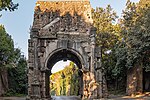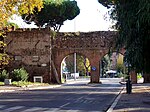San Giovanni a Porta Latina
5th-century churchesBasilica churches in RomeChurches of Rome (rione Celio)Titular churches

San Giovanni a Porta Latina (Italian: "Saint John Before the Latin Gate") is a Basilica church in Rome, Italy, near the Porta Latina (on the Via Latina) of the Aurelian Wall.
Excerpt from the Wikipedia article San Giovanni a Porta Latina (License: CC BY-SA 3.0, Authors, Images).San Giovanni a Porta Latina
Via San Giovanni a Porta Latina, Rome Municipio Roma I
Geographical coordinates (GPS) Address External links Nearby Places Show on map
Geographical coordinates (GPS)
| Latitude | Longitude |
|---|---|
| N 41.877222222222 ° | E 12.501944444444 ° |
Address
Chiesa di San Giovanni a Porta Latina
Via San Giovanni a Porta Latina
00183 Rome, Municipio Roma I
Lazio, Italy
Open on Google Maps









